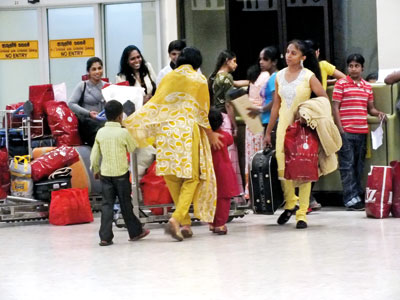Foreign Remittances: Sign of progress or regress?
View(s):In the last couple of months there has been a growing concern in the foreign exchange market about the fall in foreign remittances – that is, the money sent by Sri Lankan migrant workers to their families. The concern however just melted away as the government received over US$ 500 million from both the Hambantota deal and the IMF Extended Fund Facility (EFF).
Worker remittances are, otherwise, an important source of foreign exchange earnings of the country. Therefore, the fall of worker remittances would have serious implications on the foreign exchange market and exchange rate management.
A large part of the remittances come from West Asian countries where the majority of Sri Lankan migrants work. The fall in remittances owes much to the economic and political chaos growing in the West Asian region.
The amount of remittances earned during the past 10 months (January – October 2017), amounted to $500 million – nearly a 8 per cent decline from the same period last year. The decline in the last month of October alone was more than 12 per cent from the same month last year.
Why worry?
Perhaps, it might be bizarre to think that and worry more about the fall of remittances than about dismal export earnings. Let me explain.
According to recent data, about 250,000 – 300,000 Sri Lankans leave the country every year seeking foreign employment. In 2015 on average 721 persons per day migrated from Sri Lanka for foreign employment with about 2/3rds being males and 1/3rd being females. Majority of males belong to “skilled labour” categories, while majority of females (as high as 81 per cent) were domestic workers. Even though reliable data is not available, it is believed that about 2 million Sri Lankans are now working in foreign countries.
Over the past 20 years up to 2016, merchandise exports have only doubled, reaching $10 billion and exports of both goods and services only tripled, reaching $17 billion. Growing faster than that, however, worker remittances have increased “seven-fold” reaching $7 billion in 2016. If these rates of increase continue to remain, in a couple of years’ time, Sri Lanka’s top most foreign exchange earning sector would be worker remittances. By no means would it be considered a commendable achievement for a developing country.
Heart of the problem
Only a few countries in Asia are seen pushing their people to go abroad and find employment. If they are developing countries, and specially “smaller developing” countries, then the labour migration needs to be looked at differently, because it may not be a sign of prosperity, but of misery. For labour-abundant big countries such as India and China, it may not be an issue. But for a small developing country like Sri Lanka it is an issue.
Most of the migrant workers choose this option because they do not have a choice. If they do have better choices available at home, I believe migration for jobs may not be as great as it appears to be today.

File pic of migrant workers at the airport
Politicians may like it from a political point of view because it would reduce unemployment problem and a foreign exchange shortage. In fact, there are diplomatic missions in foreign countries (mainly West Asia) created purely for the purpose of seeking job opportunities for their own people.
Sri Lanka has about 380,000 unemployed by mid-2017, which is 4.5 per cent of the workforce. Foreign employment is one important reason for the lower unemployment in Sri Lanka, which would otherwise have been much higher than this. Lower unemployment in Sri Lanka is, therefore, not a result of successful domestic economic policies.
Apart from that, foreign employment would also bring about other benefits:
There will be job agencies connecting demand for and supply of jobs for migrant workers. Even the government can create government agencies to look after migrant workers and their welfare issues. With all these outcomes, can we identify growing remittances as a sign of progress?
I am not focusing here on costs and benefits to the families. Neither are there comprehensive studies on net assessment of financial gains, social costs, and family agonies of worker migration.
Inability of the home economy
People decide to leave their home country, because the economy is not capable of absorbing their human resources into the production process and the economy is not rewarding them adequately; both are symptoms of dismal economic performance. We would never find a country that has become developed by dumping its valuable human resources abroad, but absorbing them into the development process.
Over the past 20 years Sri Lankan departures for foreign employment have nearly doubled; it was 150,000 per year in 1997, and 300,000 in 2014. The share of migrant workers in the “skilled” categories has also increased significantly; in 1997, the share of skilled workers was about 20 per cent of total departures, whereas in 2015 this share has increased to over 40 per cent of total.
One thing is sure; if the lives of people become harder in the home country, there will be more people leaving for foreign jobs and there will be growing remittances’ flows. It would be even worse than that when there is an increase in the share of skilled labour migration. It is the labour in the “skilled” categories which is more productive and more demanded in high-performing economies.
Exchange rate implications
The exchange rate (rupee price of foreign currency) is determined by the supply of and demand for foreign exchange, until and unless the Central Bank intervenes to manage it. Supply of foreign exchange is given by all sorts of foreign exchange inflows (including foreign borrowings). Demand for foreign exchange is given by all sorts of foreign exchange spending (including the repayment of foreign loans).
The exchange rate should be “realistic” in a sense that it should reflect the country’s international competitiveness in its productive capacity.
During the first half of 2017, Sri Lanka’s exports of goods and services amounted to $9 billion, and the payments for imports $12 billion, leaving a deficit of $3 billion; the constant trade deficit shows the weak international competitiveness of the country, which has been a persistent problem of Sri Lanka’s external balance sheet. In other words, this shows the persistent supply shortage of foreign exchange.
However, the trade deficit was constantly cushioned by growing worker remittances, easing the pressure on the exchange rate. During the first half of 2017 too, worker remittances accounted for $3 billion so that we could avoid significant pressure on exchange rate.
By the way remittances doesn’t reflect the international competitiveness of Sri Lanka’s productive capacity, but rather the opposite. However in the absence of export performance, Sri Lanka’s foreign exchange market desperately depends on worker remittances; apparently its fall is a cause for panic.
(The writer of this weekly column in the Business Times dealing with economic issues is Professor of Economics at the Colombo University)


